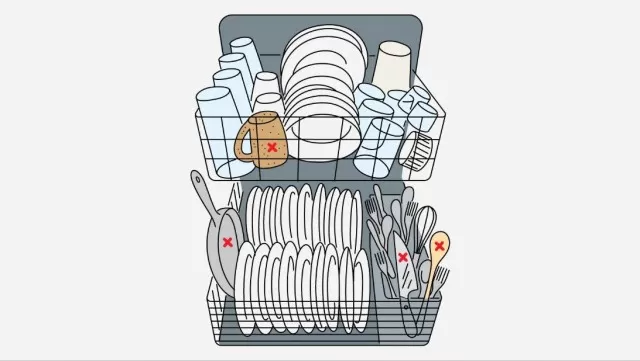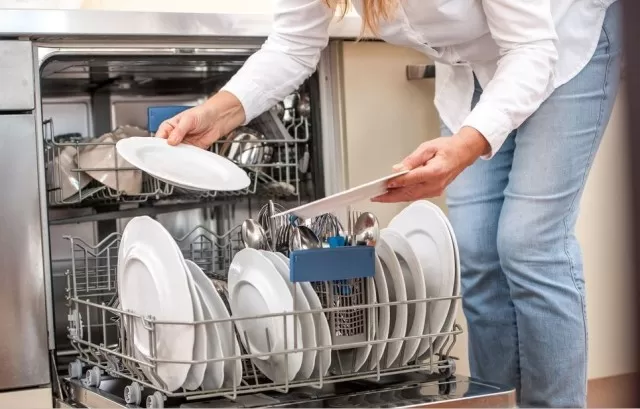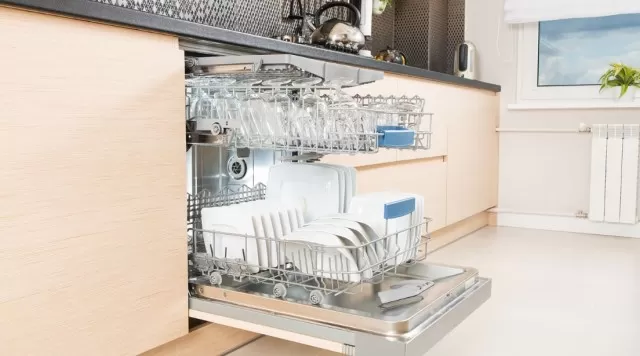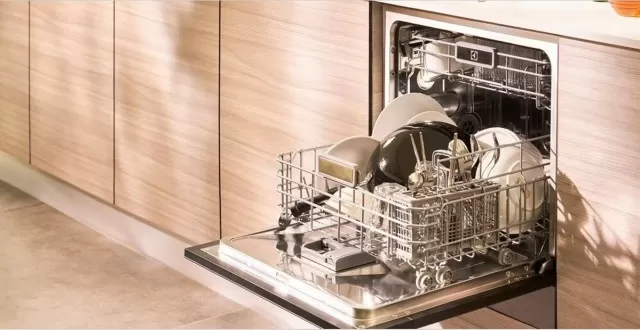Indeed, cleaning your dishwasher is an essential task to maintain its efficiency and prevent unpleasant odors.
Over time, the accumulation of residue and bacteria can affect the cleanliness of your dishes and the performance of the appliance.
Regular cleaning helps remove food particles, grease, Soap Scum, and other deposits that can build up on the dishwasher’s door and interior.
In addition to the visual and odor concerns, keeping your dishwasher clean also promotes better hygiene in your kitchen.
Bacteria and mold can thrive in the warm and moist environment of a dirty dishwasher, potentially contaminating your dishes and utensils.
By incorporating dishwasher cleaning into your routine maintenance, you can ensure that your dishwasher continues to function optimally, extends its lifespan, and provides you with clean and odor-free dishes.
Clean Dishwasher Door

Clean the Exterior:
Wipe the outside of the dishwasher door with warm, sudsy water.
You can also use a homemade dishwasher cleaner by mixing 1/4 cup of baking soda with 1 quart of water. Avoid using harsh cleansers or abrasive scouring pads that could potentially scratch the dishwasher’s finish.
After cleaning, wipe the door dry with a soft cloth. For stubborn fingerprints and smudges, use a soft, dry cloth with a little Rubbing Alcohol.
Clean Inside the Door:
Open the dishwasher door to access the top and sides.
Dip a small toothbrush into the hot, soapy water and scrub around the door, paying special attention to the grooves of the rubber seal and any other crevices, including the hinges. If there is significant buildup, you may need to use a gentle abrasive cleanser for thorough cleaning.
After scrubbing, use a household sponge dipped in hot soapy water to wipe away the grime. Finally, use a clean, wet sponge to remove any remaining cleaning solution.
Regularly cleaning the dishwasher door helps maintain its appearance and prevent the buildup of dirt and grime.
It also ensures that the door seals properly, providing an efficient and hygienic dishwasher operation.
Clean Dishwasher Tub

Remove Debris:
Use a handful of paper towels to grab any visible debris from the base of the dishwasher, particularly around the drain area.
This will help remove any large particles that may be causing odors or clogs.
Run an Empty Cycle:
Run a cleaning cycle in your dishwasher without any dishes or utensils inside.
You can use a DIY dishwasher cleaner to effectively clean the tub. One popular method is using white vinegar.
Place a dishwasher-safe cup filled with plain white vinegar on the top rack of the dishwasher. Select the hottest water setting available to disinfect the unit while it cleans.
Start the cycle and let it run its course.
Wipe the Inside:
Once the cleaning cycle is complete, open the dishwasher and carefully wipe the inside surfaces with paper towels or a clean, dry cloth.
Pay attention to any areas that may have residue or buildup, such as the walls, door, and corners.
Alternative Methods:
Instead of vinegar, you can use unsweetened lemonade mix or baking soda to clean the dishwasher.
Place a packet of unsweetened lemonade mix in the soap cup or sprinkle a cup of baking soda on the bottom of the tub. Then run a complete cycle with the hottest water setting available.
Regularly cleaning the tub of your dishwasher helps remove debris, odors, and buildup, ensuring that it functions optimally and leaves your dishes clean and fresh.
Clean Dishwasher Accessories and Parts

Remove Racks and Utensil Holders:
Take out the racks and utensil holders from the dishwasher.
These can usually be lifted out or detached, depending on the design of your dishwasher.
Wipe off Food Particles:
Inspect the racks and utensil holders for any stuck-on food particles or debris.
Use a damp cloth or sponge to wipe off and remove any residue. For stubborn residue, you can use mild Dish Soap or a mixture of warm water and vinegar.
Scrub the Spray Arm:
The spray arm is responsible for distributing water during the wash cycle.
Over time, it can become clogged with debris or mineral deposits. Use a soft brush or toothbrush to scrub the spray arm and remove any clogs.
Pay attention to the spray holes and ensure they are clear of any obstructions.
Rinse and Dry:
Once you have cleaned the dishwasher accessories and parts, rinse them thoroughly with Clean Water to remove any soap or cleaning residue.
Dry them completely before reinstalling them back into the dishwasher.
Reinstall the Accessories and Parts:
Place the cleaned racks and utensil holders back into the dishwasher in their proper positions.
Ensure they are properly aligned and secure.
By regularly cleaning and maintaining the dishwasher accessories and parts, you can help improve the dishwasher’s performance and ensure clean dishes.
Clean Dishwasher Filter

Access the Filter:
Pull the bottom rack of the dishwasher out to access the filter.
The filter is typically located in one of the bottom corners of the appliance. Consult your owner’s manual for the specific location of the filter in your dishwasher.
Remove and Rinse the Filter:
If your dishwasher filter is removable, twist it to detach it from the dishwasher.
Rinse the filter under hot running water to remove any food particles, debris, or residue. Use a soft brush or toothbrush to gently scrub the filter if needed.
Ensure that all the clogged particles are thoroughly removed.
Clean the Area Under the Filter:
Wipe the area beneath the filter inside the dishwasher with a damp cloth, sponge, or toothbrush.
This will help remove any accumulated debris or residue that may be present. Pay attention to corners and crevices where buildup can occur.
Reinstall the Filter:
Once the filter and the area beneath it are clean and dry, reinsert the clean filter back into its original position.
Make sure it is properly secured or locked in place according to your dishwasher’s design.
Please note that the specific steps for cleaning the dishwasher filter may vary depending on the make and model of your dishwasher.
It’s recommended to consult your owner’s manual for detailed instructions specific to your appliance. If you don’t have the manual, you can often find it on the manufacturer’s website.
Remove Rust Stains From the Dishwasher

Run an Empty Dishwasher:
Check your local home center for rust stain removal products that are designed for use on clothing or appliances.
Place the recommended product into the dishwasher’s soap dispenser cup and sprinkle some on the bottom of the dishwasher. Make sure the dishwasher is empty.
Run the dishwasher through a complete cleaning cycle according to the manufacturer’s instructions.
Address the Source of Rust:
Since rust stains are typically caused by systemic issues such as rusty water or corroded pipes, it’s important to address the root cause to prevent future rust stains.
Consider taking the following steps:
a. Water Source:
If your water comes from a private well and is the source of rust stains, you may need to install a water filtration system or consult with a plumbing contractor to address the rust issue.
b. Corroded Pipes:
If your home’s pipes are rusty and causing stains, it’s advisable to contact a plumbing contractor to assess the situation.
They may recommend pipe replacement or other solutions to mitigate the rust problem.
Regular Maintenance:
Depending on the severity of the rust issue, you may need to repeat the rust stain removal process regularly until the underlying problem is resolved.
Additionally, consider installing a filter specifically designed to address rust control in your dishwasher.
By running an empty dishwasher with a rust stain removal product, addressing the source of rust, and implementing regular maintenance, you can effectively remove dishwasher rust stains and prevent their recurrence.
Eliminate Hard Water and Mineral Buildup in Dishwasher

Lemon Juice Treatment:
Place a cup of lemon juice in the top rack or basket of your dishwasher.
Make sure the dishwasher is empty. Lemon juice contains citric acid, which helps dissolve and remove hard water spots and mineral deposits.
Run a Normal Cycle:
Start a normal dishwasher cycle with the lemon juice inside.
The heat and water action will activate the acidic properties of the lemon juice, working to eliminate the buildup.
Regular Maintenance:
It’s a good idea to perform a thorough cleaning of your dishwasher once a month to prevent mineral buildup and maintain its efficiency.
Additionally, promptly clean any smudges and splatters on the exterior as they occur.
By using lemon juice and running a regular dishwasher cycle, you can effectively tackle hard water spots and mineral buildup.
Remember to perform routine maintenance to keep your dishwasher in optimal condition.
Clean Dishwasher with Natural Ingredients

White Vinegar:
To clean the interior of the dishwasher, place a cup of white vinegar in the middle of the top rack.
Make sure the dishwasher is empty. Run a full cycle on high heat.
The vinegar will help remove any buildup and odors. After the cycle is complete, wipe the interior dry.
Lemon Juice:
Alternatively, you can use lemon juice instead of vinegar to remove water spots and add a fresh scent.
Follow the same process as with white vinegar.
Rubbing Alcohol:
To clean the exterior of the dishwasher, especially the door and handle, dampen a clean microfiber cloth with rubbing alcohol.
Wipe away fingerprints and smudges. Avoid using acidic natural cleaners like vinegar on plastic buttons, as it can damage them.
Baking Soda:
Sprinkle a cup of baking soda on the bottom of the dishwasher tub.
Run a hot washing cycle. Baking soda helps eliminate odors and acts as a natural cleaning agent.
It will leave your dishwasher fresh and clean.
By using these natural ingredients like white vinegar, lemon juice, rubbing alcohol, and baking soda, you can effectively clean your dishwasher without harsh chemicals.
*The information is for reference only.